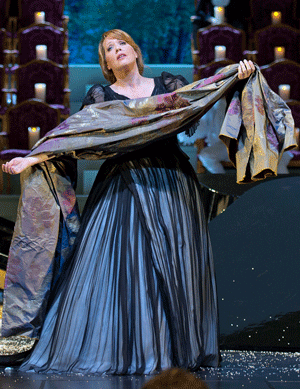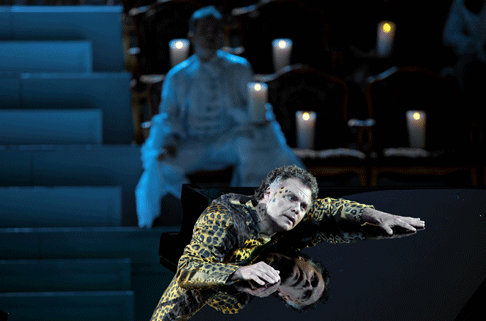What materialised was something rather different, which ultimately delivered less than it might have seemed to promise. The Salzburg Festival’s Director of Drama not only directed the stage proceedings, but offered a new version of his own. Hofmannsthal’s adaptation of MoliËre’s Le bourgeois gentilhomme is itself adapted so as to form the basis of a further level of metatheatricality. Nothing wrong with that in principle; indeed Strauss tends to thrive on such Êsthetic play.
 Emily Magee (The Prima Donna/Ariadne)
Emily Magee (The Prima Donna/Ariadne)
The problem, however, is that the new level is ultimately banal, an explanation of the enterprise being a Hollywood love-story between Hofmannsthal and Ottonie von Degenfeld-Schonburg. What most interests many of us about Strauss is the fraught relationship, and sometimes serene disconnection dialectically reinforcing itself as in connection, between life and work. Presentation of a vulgar, sub-Romantic ‘life explains works’ story cheapens rather than intrigues. Otherwise, Bechtholf’s production is unobjectionable. Rolf Glittenberg’s set designs are stylish, likewise Marianne Glittenberg’s costumes, save for an unfathomably dreadful leopard-skin get up for Bacchus. (Zerbinetta likens his stealing forward to that of a panther, but even so…)
Added to this mix prior to the interval are certain parts of the later, 1916 Prologue, albeit spoken. What a waste to reduce the Composer to a spoken part! At least, however, we have opportunity to hear the incidental music. Then, after the interval, comes the opera proper, albeit with interventions from Hofmannsthal and Ottonie — yes, their love bears fruit at the same time as that of Ariadne and Bacchus — and, more irritatingly, from the dreadful M.Jourdain, objecting, in a fashion doubtless considered ‘witty’, that the music might be beautiful but it lacks a French horn, that Ariadne does nothing but complain, and so on. Many of these ideas might have sounded good on paper, even in discussion, but would have been better off rejected when it came to practical rehearsal. Yes, we hear the opera music for 1912, but we do not hear it as conceived: a pity, when even this problematical first version is so manifestly greater in sophistication than this 2012 Salzburg ‘version’. It was fascinating to hear what remained from 1912, but it would have been still more fascinating to have heard it all.
 Roberto Sacc‡ (Tenor/Bacchus)
Roberto Sacc‡ (Tenor/Bacchus)
After an occasionally shaky start, the Vienna Philharmonic was on good form. Daniel Harding shaped the incidental music before the interval with knowledge both of its French Baroque origins and the affectionate almost-but-not-quite neo-classicism in which Strauss clothes it. The Overture in retrospect offered something of an exception, more Stravinskian than what was to come, but not jarringly so. Form was conveyed intelligently and meaningfully throughout the opera, a more than satisfactory balance achieved between ‘numbers’ and the greater whole. The final climax was thrilling, moving as it should, the chamber orchestral forces persuading one, in a moment of echt-Straussian magic, that they are larger than they are, both consequence and deflation of Wagner’s examples. (The earlier Tristan quotations did not fail to delight, nor, of course, to raise a smile.)
Emily Magee was an adequate Ariadne, but rarely more than that. Too often, her voice failed to soar as it should; an edge to it proved a touch unpleasant. Elena Mo?uc, by contrast, proved an outstanding Zerbinetta. Her extended aria, up a semitone, was delivered as flawlessly as I can recall any performance of the somewhat easier — that is, of course, relative! — 1916 version. The 1912 aria is even more outsized, even more absurd, in its way even more lovable; at least, that was how it sounded here. Roberto Sacc‡ did a fine job in the thankless role of Bacchus; if he could not quite manage to prevent the strain from showing, and could not quite help one long for Jonas Kaufmann, who performed the role earlier in the run, there was a great deal for which to be grateful and nothing which to object. (Apart, that is, from the costume.) Zerbinetta’s followers were full of character and inviting of tone; it would really be invidious to choose between Gabriel Berm˙dez, Michael Laurenz, Tobias Kehrer, and Martin Mitterrutzner. Likewise the other smaller sung roles. If the actors impressed less, it was difficult to know whether that was simply on account of the material. At any rate, I assume the over-acting of Cornelius Obonya’s M. Jourdain was at least in part on directorial instruction.
Will someone now offer us the 1912 version we were promised? And then we can return safely to the unalloyed joys of 1916.
Mark Berry
image=http://www.operatoday.com/ARIADNE_AUF_NAXOS0084a.gif
image_description=Michael Laurenz (Scaramuccio), Gabriel Berm˙dez (Harlequin), Elena Mo?uc (Zerbinetta), Martin Mitterrutzner (Brighella), Tobias Kehrer (Truffaldino)[Photo © Ruth Walz]
product=yes
product_title=Richard Strauss: Ariadne auf Naxos
product_by=Prima Donna/Ariadne: Emily Magee; Zerbinetta: Elena Mo?uc; Tenor/Bacchus: Roberto Sacc‡; Naiad/Shepherdess: Eva Liebau; Dryad/ Shepherd: Marie-Claude Chappuis, Echo/Singer: Eleonora Burato; Harlekin: Gabriel Berm˙dez, Scaramuccio: Michael Laurenz; Truffaldin: Tobias Kehrer; Brighella: Martin Mitterrutzner; Major-Domo: Peter Mati?; Monsieur Jourdain: Cornelius Obonya; Composer: Thomas Frank; Hofmannsthal: Michael Rotschopf; Ottonie/Dorine: Regina Fritsch; Nikoline: Stefanie Dvorak; Lakai: Johannes Lange. Sven-Erik Bechtholf, director. Rolf Glittenberg set designs. Marianne Glittenberg costumes. Heinz Spoerli choreography. J¸rgen Hoffmann lighting. Ronny Dietrich dramaturgy. Vienna Philharmonic Orchestra. Daniel Harding conductor.
Haus f¸r Mozart, Salzburg, August 2012
product_id=Above: Michael Laurenz (Scaramuccio), Gabriel Berm˙dez (Harlequin), Elena Mo?uc (Zerbinetta), Martin Mitterrutzner (Brighella), Tobias Kehrer (Truffaldino)
All photos © Ruth Walz courtesy of the Salzburg Festival